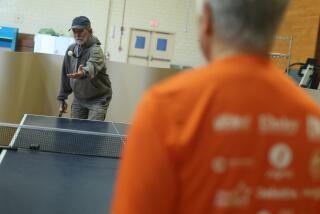Forever the Senior Class : Emeritus Institute Keeps Older Students Active, Intellectually Fit
- Share via
MISSION VIEJO — What student hasn’t dreamed about life without homework, classes without note-taking and playing hooky without getting busted?
About 8,700 students who are enrolled in Saddleback College’s Emeritus Institute live that dream. Among them are retired aerospace engineers, doctors and people with Ph.D.s who believe that life is a never-ending school and they must sit in the front row.
These are students who no longer see education as a passport to a lucrative job or a decent career. Attending classes here is mental exercise, a way to keep the brain ticking and the doctors away.
Some students don’t merely study history, they’ve participated in it. Take 82-year-old Henry Heller, a doctor who came to the United States after escaping the gas chambers in Auschwitz.
Heller leaves professors spellbound when he talks about surviving six years in Nazi concentration camps. He says he attends classes because “the best exercise for the brain is to be in class and . . . I don’t want my brain to dry up.”
The institute was only 4 years old when Heller enrolled in 1980 after retiring from his Chicago practice and moving to the Leisure World retirement community. The school was created to meet the needs of a rapidly growing population of senior citizens who were flocking to gated retirement havens in South County. Today, the institute’s enrollees represent one-third of the Saddleback Community College District population.
Many of the adult students are people like Heller, who says he could never find time to read books and study other disciplines while he was practicing medicine. Some take language courses so that they can travel abroad, while others simply stay in school to meet friends or keep abreast of current events.
Eugene McKnight, a retired Saddleback philosophy professor who as a board trustee lobbied for the emeritus program, says the institute’s success is priceless.
“We forget that education is an ongoing process,” says McKnight, 86. “But it’s so therapeutic. For many of us, it’s coming full circle . . . going to school again.”
It’s probably one of the most efficient institutes in the state, said Kathie O’C. Hodge, dean of continuing education at Saddleback. Although the institute’s students make up one-third of the Mission Viejo college’s population, the program accounts for only 3% of the college’s $35-million annual budget.
The senior citizens choose from 200 classes a semester, from calisthenics to computer technology to intarsia--a dying Persian art in which colored stones are arranged within a frame to create a picture.
Many of the classes are held within retirement communities or at senior centers in South County, mainly during the day to accommodate senior citizens who have impaired night vision and are not able to drive.
Younger students may think it’s the ideal school. There are no homework assignments, and some students can take the day off if it’s a beautiful day out.
Instructors say they must always be alert because their students are educated people who may know history firsthand.
Charles Wilbourn, who retired a few years ago after a 24-year career with U.S. military intelligence, teaches political science at the institute. Wilbourn says he is no longer surprised when a student in his class talks about a historical event from personal experience.
One day in a class on Israel, Wilbourn wondered aloud how terrorists had dynamited the King David Hotel in Jerusalem in 1946. A student in the class lifted his hand and asked to speak. “He said how it wasn’t easy and that ‘our people dressed as Arab milk boys to get into the hotel,’ ” Wilbourn recalls. “He said, ‘We warned the British, but they didn’t think we were serious.’ ”
Wilbourn later learned that his student was a member of Irgun, an organization that used terror tactics to drive the British out of Palestine.
“These students make teaching so easy,” Wilbourn says. “They go home and they read. You can’t fool them. If I don’t know something, I simply say I don’t know.”
Earlier this week, Wilbourn showed a video of former President Ronald Reagan sternly warning terrorists that they would meet “swift and effective retribution.” The students erupted in laughter.
It was the same President whose Administration approved the sales of missiles to Iran, explained Hoyt Gider, a 68-year-old San Clemente resident who served in the 1950s as an assistant professor at the University of Tehran.
Gider’s classmates are people like Harriet Colvin, 69, and her 73-year-old husband, David, who have become career students since moving to the Casta del Sol retirement community in Mission Viejo. The Colvins, who enroll in a couple of classes every semester, say they’ve been bitten by “the education bug,” and they now travel out of state for a few weeks at a time to attend various education programs.
In Arizona, for example, they were taught about the flora and fauna of the Southwest; in Hawaii, they studied volcanology and Hawaiian culture; later this year they plan to travel to Quebec to learn German and the history of the Laurentian region.
Students eagerly await the arrival of the institute’s schedule of classes in search of their next challenge.
The latest issue contains a credo that seems fitting for the institute: “Instruction ends in the schoolroom, but education ends only with life.”
More to Read
Sign up for Essential California
The most important California stories and recommendations in your inbox every morning.
You may occasionally receive promotional content from the Los Angeles Times.













